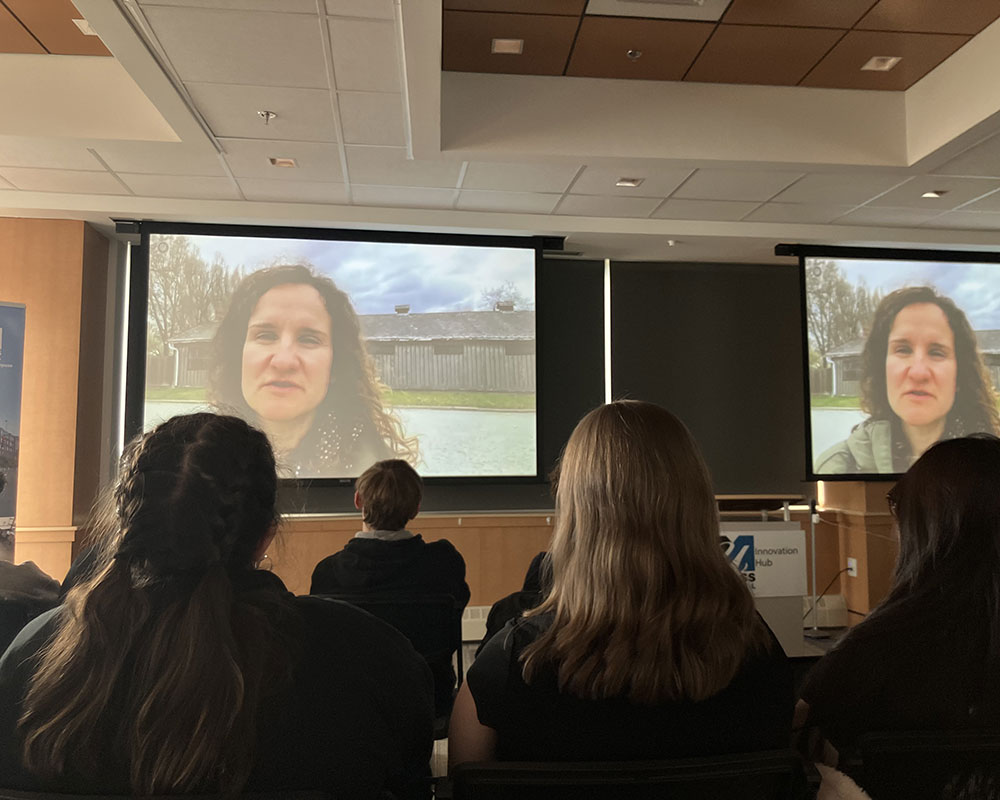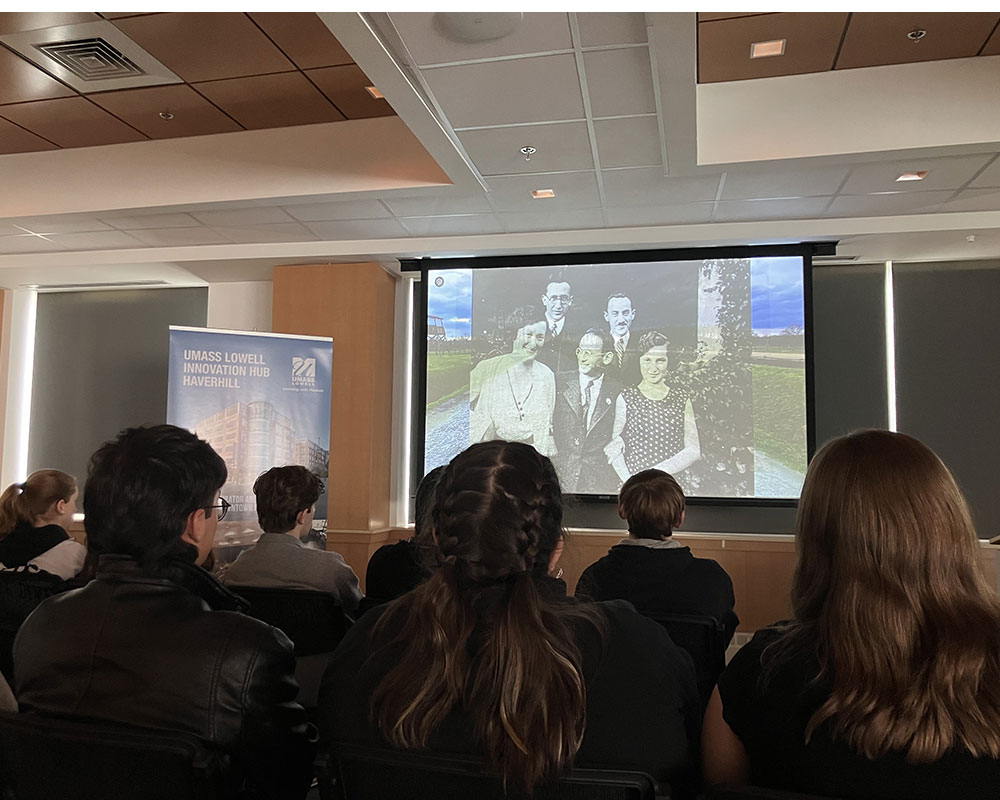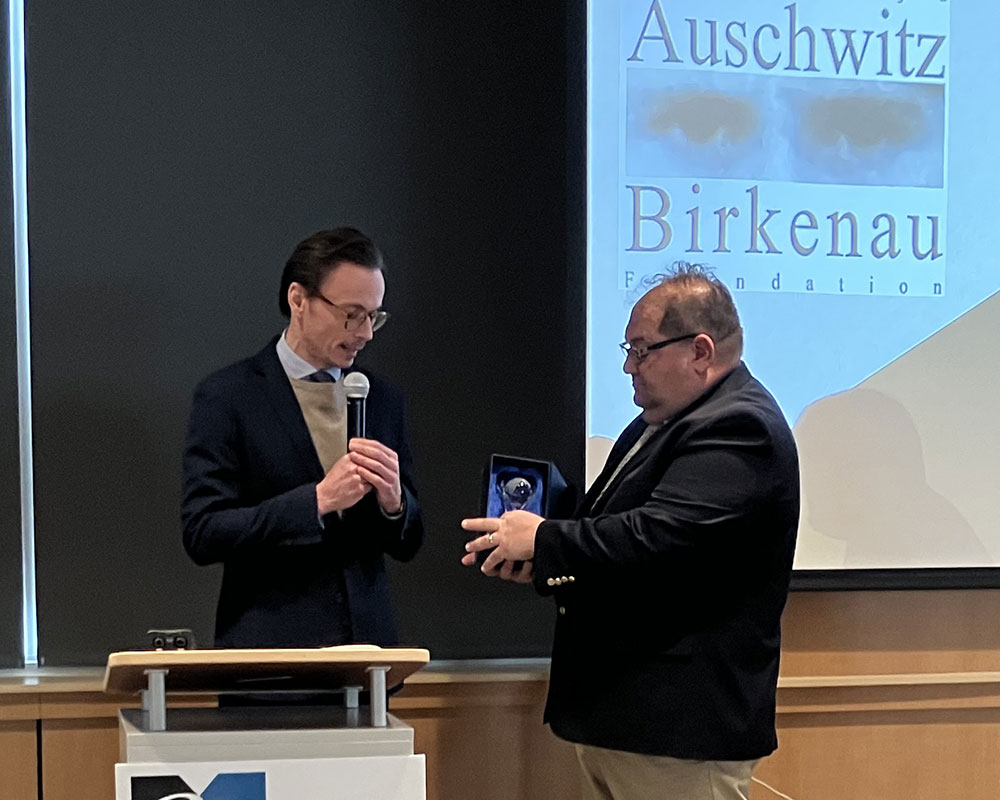(Additional photographs below.) Haverhill High School students and educators saw a live, virtual tour of the Auschwitz-Birkenau concentration camp from Harbor Place yesterday, the first of its kind in the United States.
As if the viewer is walking beside her, the projectors in the conference room showed video from the guide’s perspective as she crossed the grounds. Survivor testimony and archival images overlayed the live stream, which was interspersed with drone footage and two introductory videos. The occasional visitor coming into view, as well as snatches of conversation in foreign languages, further added to a sense of realism, of being present in the former death camp.
The learning opportunity is set to become a regular part of the ninth-grade modern world history curriculum beginning this fall. Schools in the city of Leeds, United Kingdom, are also piloting it.
Rabbi Ashira Stevens, who was one of a few to give remarks after the tour, said she has family members with direct connections to the Holocaust and “choked up many times.” She described the guide following a road to the gas chambers and crematoria as “visceral.”
“Even without being there, it was like, ‘oh, I am walking with this person, and wow this path is long, and wow, how frightening this must have been,’” she told WHAV.
With the footsteps of the guide in the background, a survivor gave testimony about hearing people scream the Hebrew word Sh’ma after being packed into the gas chambers. With people anticipating a shower after their long journey by train, concentration camp guards instead killed them with Zyklon B.
“Sh’ma is the core of our liturgy. It means ‘hear.’ It means ‘listen up.’ It means ‘pay attention,’” she said. “It comes from Deuteronomy, chapter six, verse four. And it’s what you’re supposed to say when you go to bed every night, and, ideally, what you say right before you die.”
Historians estimate around 1.1 million people died in Auschwitz, one million of whom were Jewish, over less than five years. The Nazis murdered around six million Jewish people during the Holocaust. A Haverhill High student, Emmerson Cerasuolo, told WHAV the live tour helped in wrapping her mind around the horror, which can get lost when reading an overview in a textbook
“It’s hard when you just hear a big number—it’s hard for your brain to actually process it. But, seeing the individual stories, the survivors talk, it’s gut-wrenching how this really happened,” she said.
Fabio Georges, also a student, said the tour “aggravated” for him the prisoners’ dehumanization in Auschwitz, making him “angry.” Hunting for a word, another student called the tour “realistic.” Others offered “shocking” and “daunting.”
The students in attendance are in history teacher Ted Kempinski’s AP U.S. Government and Politics class. This was the second time the class went on the tour—the first was two weeks ago —and junior David Martinez said attending it again made it no less devastating. As WHAV reported last month, Kempinski was instrumental in bringing the tour to Haverhill after attending a conference in Poland this summer.
He partnered with Auschwitz-Birkenau Foundation Director-General Wojciech Soczewica, who flew in two days ago to speak after the tour. School administrators presented him with an award. He told the audience the initiative came out of his organization’s desire to continue its work during the Pandemic. He said he never expected to find himself on so many Zoom calls with Kempinski.
The goal with the efforts in Haverhill and Leeds is not to replace in-person visits, but to expose those who might never otherwise see the grim reality of Auschwitz, Soczewica explained. In his view, the key to combatting Holocaust misinformation is to present people with hard evidence: documents in the archive, structures that still stand and the testimony of survivors.
Retired history teacher Tom Jordan also emphasized the importance of strong arguments in proving to doubters that it really happened. While it is uncommon, he said he has encountered students who do not know about the Holocaust.
“Kids come in not knowing very much,” Jordan said. “Just as open as they are to the fact that it did happen, they are also open to saying, ‘maybe it didn’t, maybe that’s a Boomer teacher talking about some old stuff.’ And the further you get away from the events that happened, it’s easier just to say, ‘well, I don’t know, did it happen?”
Parents may choose to have their child opt out of the tour, which will fit into the curriculum ninth grader teachers created with the help of two nationally recognized organizations, Facing History & Ourselves and Echoes & Reflections. An adjustment counselor will be present at all the tours. At the event yesterday, one told WHAV he helps students unpack the ways the tour may resonate with difficult experiences in their own lives, which can cause emotional distress.

Haverhill High School students and educators watch a live, virtual tour of the Auschwitz-Birkenau concentration camp. (WHAV News photograph.)

Students see some of the victims of the Nazis’ murder of around six million Jewish people during the Holocaust. (WHAV News photograph.)

